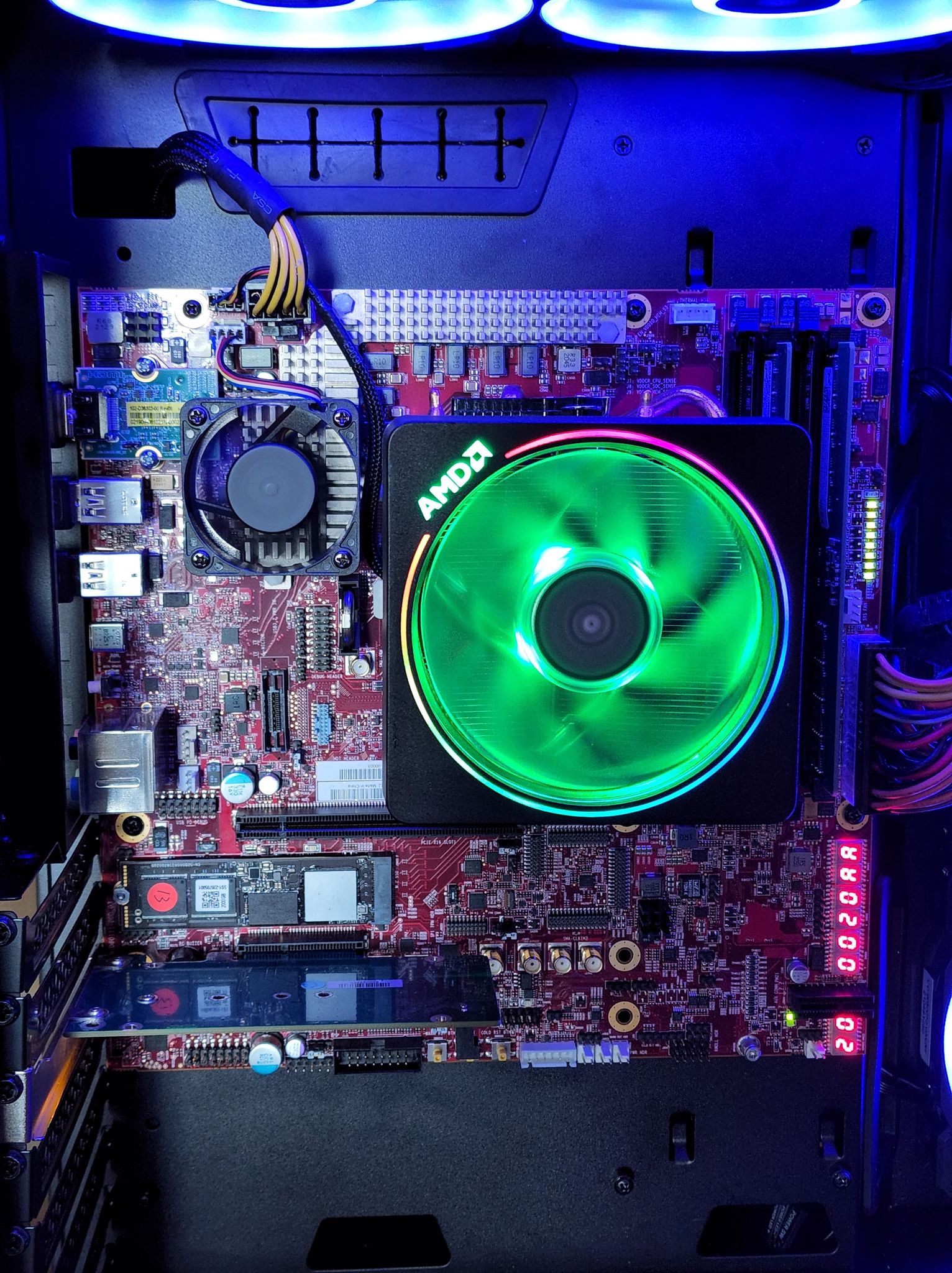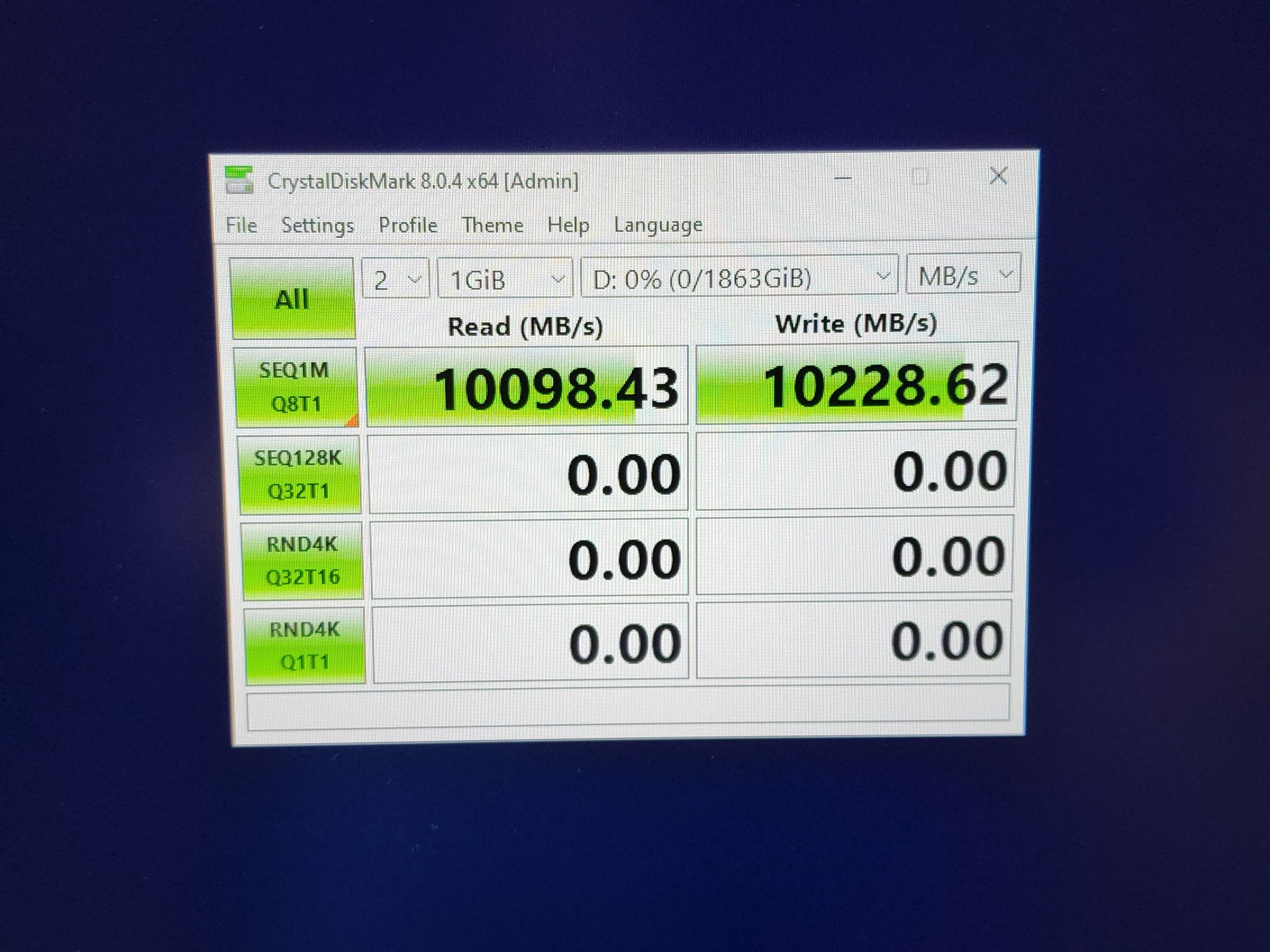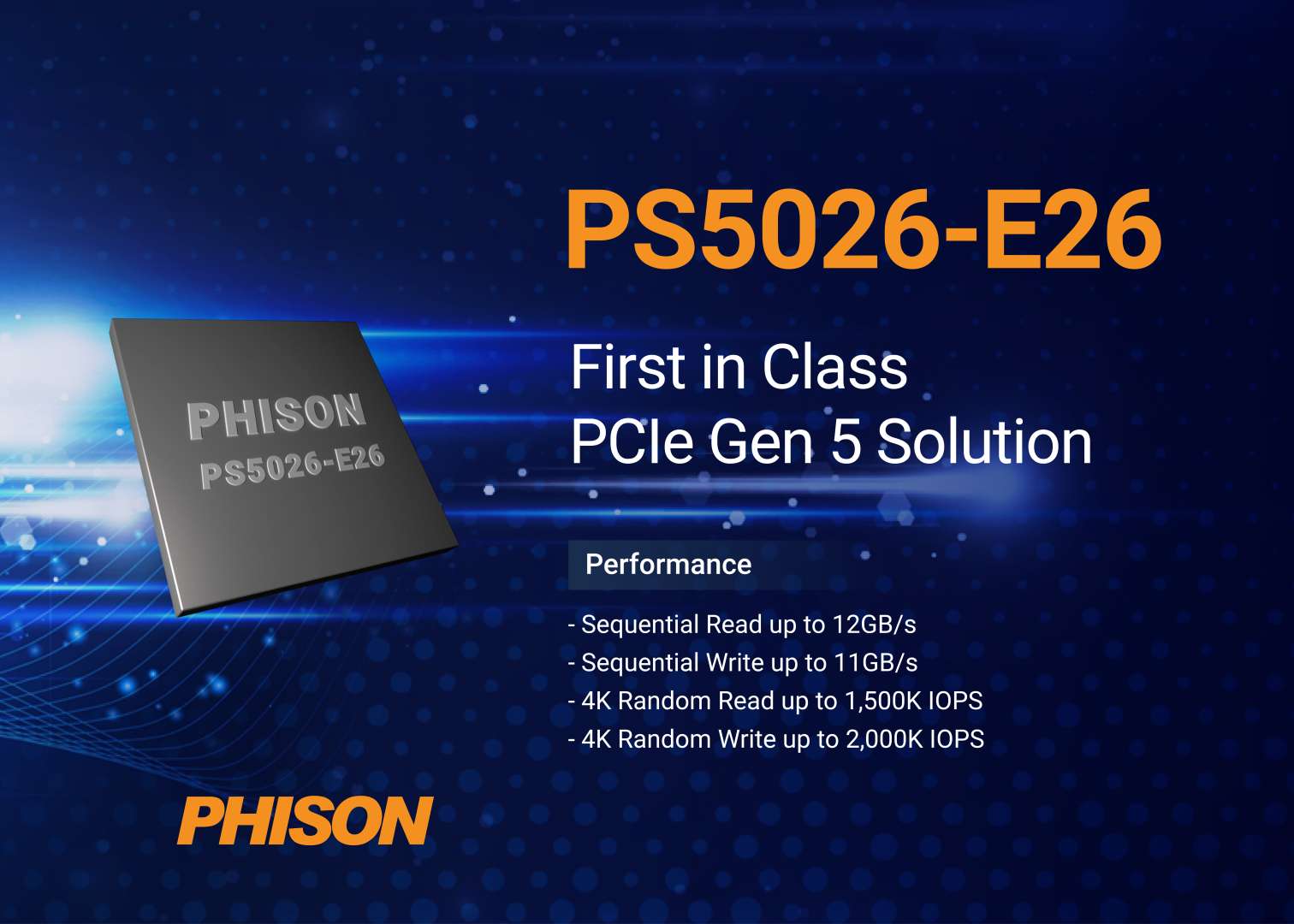AMD Ryzen 7000 Demoed With Phison PCIe 5.0 SSD and Micron's 232-Layer NAND
Cranking the dial up to 10 GBps.

In the first sighting on a Ryzen 7000 system outside of AMD's own demos, Phison today showed off its PCIe 5.0 SSD controller dishing out slightly more than 10 GBps of throughput on a Zen 4-powered system at the 2022 Flash Memory Summit.
Phison has partnered with AMD and Micron for the launch of its PS5026-E26 SSD controller, more commonly known as the E26, and those drives will come to retail in September. Given that AMD has said PCIe 5.0 SSDs will be available in time for its Zen 4 launch, it appears the pieces will be in place for the Ryzen 7000 launch that's rumored to occur on September 15.
Phison's test system consists of a six-core, twelve-thread AMD processor on a developmental motherboard that obviously has the PCIe 5.0 interface up and running. Unfortunately, Phison won't share any details about the system or test platform, although we gleaned that the chip has the 100-000000593-20_Y codename. We can see a fan on the VRMs and two sticks of DDR5 on the system, but closer inspection isn't allowed — what we can see is what we get.

We've already seen the E26 controller hit up to 12GB/s of throughput and provide up to 1.3 / 1.1 million random read/write IOPS in previous demos, but this sample finds the E26 paired with Micron's new 232-Layer B58R TLC flash, a first, so it is still in the tuning stage.
Micron says its new 232-Layer TLC flash provides twice the write bandwidth and 75% higher read bandwidth than its previous version. But the move to a six-plane architecture (from four planes) means that companies like Phison will have to tune their SSD controllers accordingly. For now, this flash runs at 1600 MT/s, but it will eventually reach up to 2000 MT/s.
Here we can see 10 GB/s of read/write throughput on the AMD test system, but Phison reminds us that this configuration is still in the developmental phase. The company plans for up to 12 / 11 GB/s of sequential read/write throughput and 1.5 / 2 million random read/write IOPS when the final drives arrive on the market.
Phison is also preparing its I/O+ firmware to optimize SSDs for DirectStorage workloads, which we recently tested with a PCIe 4.0 SSD. Naturally, PCIe 5.0's higher sequential performance will be great for Microsoft's DirectStorage because it relies heavily upon read throughput to reduce game loading times to roughly a second.
AMD also says Ryzen 7000 will support Smart Access Storage (SAS), which appears to be a slightly tweaked version of DirectStorage that's built on the same APIs. Given Phison and AMD's close collaboration, we expect the company's SSDs to support AMD's SAS.


A close-up pic of the SSD shows the standard M.2 2280 form factor, meaning it has the standard 22mm width. A new 25mm-wide form factor was recently added to the NVMe spec, ostensibly for PCIe 5.0 SSDs. But Phison tells us that it doesn't have any plans to create wider form factors for its E26-powered drives. You can also see that the demo SSD doesn't have an affixed heatsink, but Phison says one will be required for the best performance.
A constellation of third-party SSDs will use Phison's E26 PCIe 5.0 SSD controllers. That will come in handy for Zen 4 Ryzen 7000 systems — AMD claims a 60% performance gain in sequential read workloads with PCIe 5.0 SSDs. The first E26-powered drives arrive in September.
Get Tom's Hardware's best news and in-depth reviews, straight to your inbox.

Paul Alcorn is the Editor-in-Chief for Tom's Hardware US. He also writes news and reviews on CPUs, storage, and enterprise hardware.
-
rluker5 Imagine the difference when you get 2 and move files from one to the other!Reply
Would be nice if they showed randoms though. That was the difference when you went from HDD to SSD. Since then, going from SATA to NVME and up the PCIe gens really feels like not much difference. Even with Optane. You can tell the difference in game reloading when you die, or just want to do something different/better but it isn't that big.
In game reloads are much more common and the performance is much more important IMO than the performance increase cold loading a game when you first start it. You are already playing and are immersed and invested, not just getting set up for that. I wonder why nobody tests these times? They also seem much more random dependent. I bet most of what has to get in the GPUs memory is already there at that point and just bits and pieces have to be added. -
LuxZg They've sure made a nice partnership...Reply
AMD: Zen 4 CPUs, AM5 socket, chipset, Radeon 7000 GPUs
Phison: PCIe 5.0 NVMe controller
Micron: DDR5 (both for system and SSD cache), GDDR6X for GPUs, 232-layer NAND for SSDs, with RAM & SSD packed for retail under Crucial brand
All they need is MBO & PSU for complete system. Not that those two would make a lot of difference in performance once you've picked everything else from the list above. -
tracker1 Replyrluker5 said:In game reloads are much more common and the performance is much more important IMO than the performance increase cold loading a game when you first start it. You are already playing and are immersed and invested, not just getting set up for that. I wonder why nobody tests these times? They also seem much more random dependent. I bet most of what has to get in the GPUs memory is already there at that point and just bits and pieces have to be added.
What you are referring to would be very hard to test for.. that said it's what the direct access APIs mentioned are to help reduce.. By transferring data directly from storage to ram or the video card cutting out the need for going through the CPU...
The trouble in testing is it would really be artificial, since natural resource contention had a lot of variables. The speed and storage of the video card, CPU, cache, ram and device storage. Too many variables to really control.
The noticeable performance differences are also going to carry a lot. The difference from a 3s scene load to under a second is more noticable than 900ms to 300ms.... Even if the tattoo is the same the hard differences are less noticeable. Much like going from 60hz to 120hz vs 240hz display. It's diminishing returns.
For me, the difference is build times for large projects... My R9 5950X sometimes gets outpaced by my M1 Max MacBook and I'm pretty sure it's the improved storage access speed.
I don't feel a need for much more CPU, aside from video encodes... But if I can get back half my build time through a day, I'd be pretty happy. -
rluker5 Reply
To test you would just have to run the games a bit and repeatedly load the same save point. The results wouldn't be absolute, they would of course be hardware dependent, but the hardware could be listed and fast hardware could be chosen to reduce the system bottlenecks as much as possible relative to the drive performance. It couldn't be perfect, but some relative comparisons could be made. That is one of the few scenarios I've seen where Optane makes a noticeable difference. But it isn't worth the price tbh. I just think it would be a good comparison. I've seen not a lot of difference between SATA and NVME and these 10k vs .6k MB/s numbers are a bit deceiving. My NVME nand isn't many times faster than my SATA nand in program or game loading and neither is my Optane that has several times the random, except some games while reloading. Otherwise most of the time it doesn't feel much different than a SATA, and can no longer match the sustained speeds of these newer PCIe gen nand SSDs.tracker1 said:What you are referring to would be very hard to test for.. that said it's what the direct access APIs mentioned are to help reduce.. By transferring data directly from storage to ram or the video card cutting out the need for going through the CPU...
The trouble in testing is it would really be artificial, since natural resource contention had a lot of variables. The speed and storage of the video card, CPU, cache, ram and device storage. Too many variables to really control.
I don't feel a need for much more CPU, aside from video encodes... But if I can get back half my build time through a day, I'd be pretty happy.
I also know how you feel with the CPU. I've got a 12700k and it is fast enough that I don't care if I slow it down to save power most of the time. But I also felt the same way with my 4770k, which my daughter now thinks she doesn't have a need for much more CPU with :P -
JWNoctis Reply
More RAM than strictly needed for the OS, the game, and any other running processes would actually be more useful (and much faster) than any SSD the same system might have, since all current desktop OS makes use of free memory as disk read cache. Might need at least 64GB to be of significant help for the latest games, though...and a fast 64GB DDR4 kit is already more expensive than a good 2TB SSD these days.rluker5 said:Imagine the difference when you get 2 and move files from one to the other!
Would be nice if they showed randoms though. That was the difference when you went from HDD to SSD. Since then, going from SATA to NVME and up the PCIe gens really feels like not much difference. Even with Optane. You can tell the difference in game reloading when you die, or just want to do something different/better but it isn't that big.
In game reloads are much more common and the performance is much more important IMO than the performance increase cold loading a game when you first start it. You are already playing and are immersed and invested, not just getting set up for that. I wonder why nobody tests these times? They also seem much more random dependent. I bet most of what has to get in the GPUs memory is already there at that point and just bits and pieces have to be added.
Oh and NVME speed certainly helps you notice when anything goes wrong. My previous M.2 SSD slowed to a <100MB/s crawl, and the only symptom was games starting to take minutes to load instead of tens of seconds. Barely got the data out - thankfully without reported read errors - and it shuffled off its mortal coil into the RMA bin when I tried to reformat it for external use. At no point did SMART show anything off except for a steadily incrementing error information log entry count, whatever that is supposed to be.
